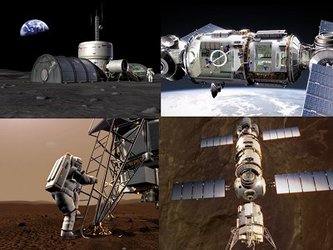Green light for Aurora Flagship missions
ExoMars and Mars Sample Return, the first Flagship missions in ESA’s pioneering Aurora programme, have received the go-ahead for detailed industrial studies.
This unanimous decision made in December by the multinational Aurora Board of Participants came after a thorough evaluation of the preliminary mission studies by the European Space Agency Research and Technology Centre (ESA/ESTEC).
As its name suggests, the ExoMars mission is expected to provide significant new insights into the surface environment of the Red Planet, with particular emphasis on exobiology, the search for signs of Martian life, past or present.
As currently envisaged, the ExoMars orbiter will release a descent module and solar-powered rover onto the planet’s pristine surface. Equipped with a drill and sampling system, this autonomous roving vehicle will spend many months exploring the hostile terrain and analysing soil from sites that may be hospitable to primitive Martian life forms.
The mission will also carry four Netlander surface stations provided by a consortium under the leadership of the French Space Agency, CNES. Deployed onto the planet’s surface, the Netlanders will create the first network of weather and seismic stations on our neighbouring world.
With its piggybacked payloads safely delivered, the Orbiter will act as a communication link with the Earth, relaying images and data from the payload of instruments carried by the rover and the Netlanders surface stations.
The orbiter will also carry out an important test of rendezvous and docking techniques, using a small dummy capsule that is released into an orbit several hundred kilometres away. The mother craft will then be required to locate and retrieve the capsule with the aid of long-range detection and navigation systems.
The successful demonstration of this capture capability will be essential for the implementation of Mars Sample Return (MSR), the second Flagship mission in the Aurora programme, currently scheduled for launch in 2011.
This ambitious mission will realise the dream of many planetary scientists by bringing back a sample of Martian surface material for analysis in laboratories on Earth. In order to achieve this extremely difficult objective, the MSR mission will require a spacecraft made up of four separate elements.
The descent module will carry a drill to obtain a rock core and an ascent stage that will deliver the precious sample to Martian orbit. The main MSR orbiter, which provides data relay back to Earth, will rendezvous and dock with the ascent vehicle. The sample will then be returned to Earth in a special capsule equipped to survive a ballistic re-entry though the atmosphere.
“We are delighted that the Board of Participants allowed us to go ahead with the Phase A industrial studies for ExoMars and Mars Sample Return,” said Dietrich Vennemann, the Human Missions Manager for Aurora. “We expect the call for proposals to be issued in February 2003, with a decision on the two winners around April.”
“The Mars Sample Return is a more complex mission,” he explained, “so we will continue our internal studies for four to five weeks before issuing a similar call to European industry.”
Two Arrow missions – smaller-scale flights required to demonstrate the new technologies required for the more advanced Flagship missions – have already been given the green light by the Aurora Board of Participants. Invitations to tender for these missions will also be issued to industry in February 2003.
The Arrow missions are:
Earth re-entry vehicle/capsule: A mission to test re-entry technologies using a small spacecraft placed in a highly elliptical orbit around the Earth. This is a necessary precursor for the first Mars Sample Return Mission.
Mars aerocapture demonstrator: A small mission to Mars that will validate aerobraking technology before it is applied to future Flagship missions.












